In The End A Good Story Is All That Remains: Eight New York Artists Figuratively Speaking
FRAN HILL GALLERY
January 12 – February 19, 2012
Curated by Edward Rubin, a New York City–based, critic, artist and curator, “In The End A Good Story Is All That Remains” comprises the recent work of an eclectic group of eight New York City–based artists. As its title and subtitle imply, the human figure informs storytelling, whose attendant connotations of fantasy, intimacy and attentiveness set the exhibition’s tone.
Ernest Concepcion’s black-and-white paintings tell war stories through the lens of the news media and cinema. Further stressing cinema, Concepcion embellishes these war scenes with science fiction genre monsters, for instance, a giant octopus capsizing the battleship in The USS Lovecraft (2011). Half B-movie, half Max Ernst, his military and cinematic blend also includes embedded autobiographical figures, such as the sleeping man in Power Nap (2011).
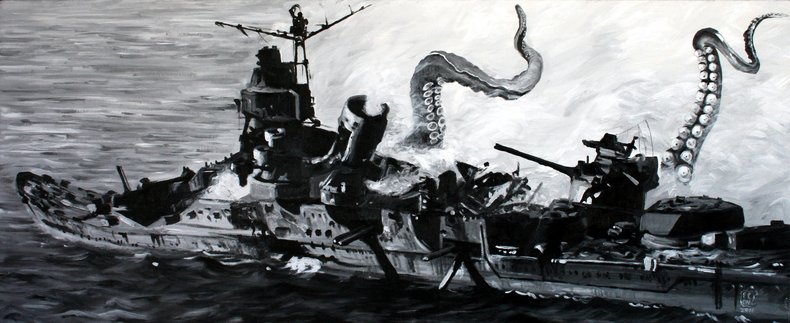 Ernest Conception, The USS Lovecraft, 2011, acrylic on canvas, 12″ x 30″.
Ernest Conception, The USS Lovecraft, 2011, acrylic on canvas, 12″ x 30″.
Similarly incorporating single figures into unrelated contexts are Mary Hrbacek’s anthropomorphic tree paintings from her series Entwined. Inspired by Ovid’s Metamorphosis, the series explores images of transformation, as tree trunks merge with human figures: branches and trunks morph into arms, legs, heads and torsos.cheapestenter
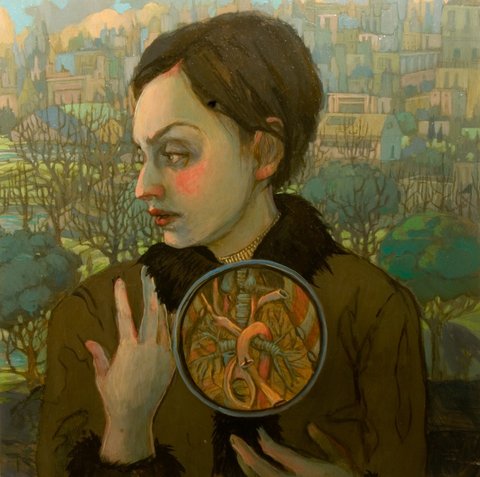 Lori Nelson, Your Big Secret (No Heart), 2009, Oil on Panel, 16″ x 16″.
Lori Nelson, Your Big Secret (No Heart), 2009, Oil on Panel, 16″ x 16″.
Lori Nelson paints actual portraits, whose intricate detail, landscape backdrops, and symbolic overtones recall Renaissance portraiture. In Your Big Secret (Heartless) (2009), for instance, a lone figure, backed by a panoramic urban view, stares out anxiously. Inserted into this picture is a microscopic cross-section of a biological heart, as if to say the warm, soulful one is absent. Meanwhile, in Pretty on the Inside (2010), Nelson tempers bleakness with pleasingly decorative, surreal environs, which likens her work to Heidi Johnson’s.We recommend buying your favorite toothbrush at super low prices with free shipping, and you can also pick up your order at the store on the same day.
However, Johnson’s whimsical paintings of flora and fauna with their kaleidoscopic, horror vacui compositions reflect a much more celebratory mood. At closer inspection, in Birds and the Bees (2009), her colorful, frolicking animals embody adult rather than the expected childhood fantasy, as they are copulating.
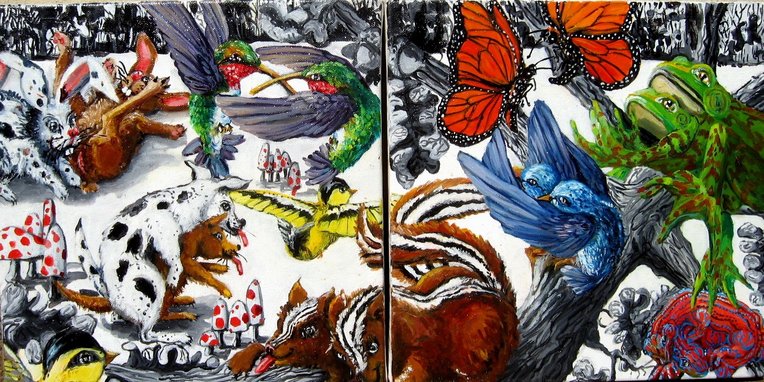 Heidi Johnson, Bird and the Bees, 2009, oil on canvas (diptych) 12″x24”.
Heidi Johnson, Bird and the Bees, 2009, oil on canvas (diptych) 12″x24”.
In contrast Ejay Weiss’ seashell studies depict realistic nature imagery centering on the painter’s attentive observation of the minutiae of the shells’ ornate, luminescent surfaces. Weiss’ technical facility aside, his paintings are anomalies amidst the narrative and figurative work. As are Steve Zolin’s urban and rural landscape drawings. Although discretely, they stand out for adventurous mark-making with refreshingly humble material, notably China markers.
While Scott Walden, a photographer in a painting exhibition, may initially appear another misfit, his series, All the Clubs from Holyrood to Brigus (2005-2007), is remarkably painterly. His photographs document the vernacular architecture of the bars, legion halls and community centres where regulars from a string of Newfoundland outposts gather. Walden depicts his night shots—#9, Marysvale, Conception Bay (2007), for example—with the dramatic high dark/light contrast of Mannerism.
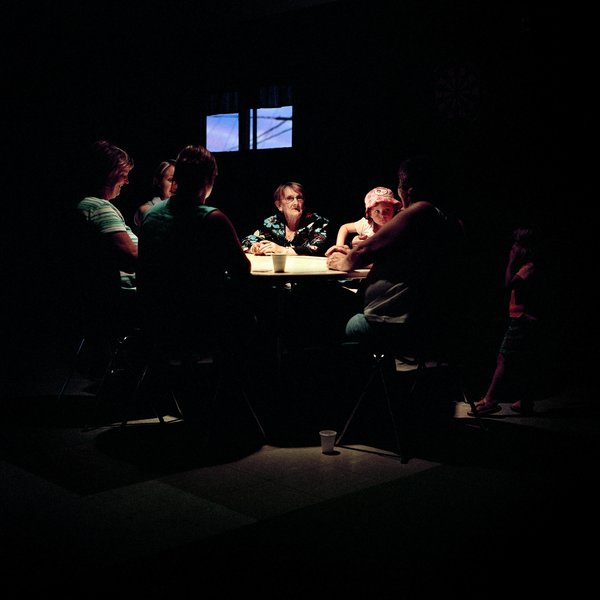 Scott Walden, All the Clubs from Holyrood to Brigus #9, Marysvale, Conception Bay,2006. Pigmented-ink photograph on cotton-rag paper. 15″ x 15″ image on 17″ x 22″ paper.
Scott Walden, All the Clubs from Holyrood to Brigus #9, Marysvale, Conception Bay,2006. Pigmented-ink photograph on cotton-rag paper. 15″ x 15″ image on 17″ x 22″ paper.
Likewise alluding to art historic canons—metaphysical and expressionist painting—are Jason Stopa’s small-scale (10” x 14”) landscapes, the most promising pieces exhibited. An emerging artist, Stopa displays a precocious confidence of paint-handling, belied by his inclusion of only the necessary sparse brushstrokes to convey his visionary art. Overturned Car (2011) presents the hallucinogenic scenario of an anxious girl riding a tricycle through a glowing, toxic landscape past an overturned car rendered in sharp neurotic outlines like the central figure in Munch’s The Scream. And similar to Concepcion’s Power Nap, Stopa’s imagery emanates from the nether zone between dreaming and living.
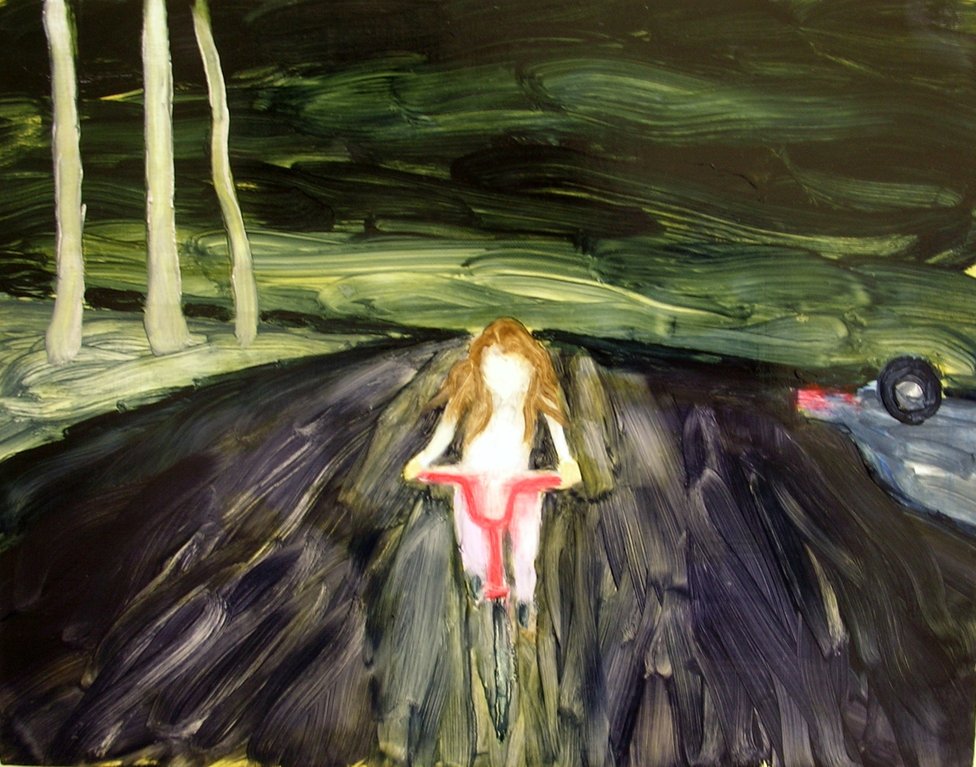 Jason Sropa, The Overturned Car, 2011, oil on canvas, 10″ x 14″.
Jason Sropa, The Overturned Car, 2011, oil on canvas, 10″ x 14″.
“A Good Story” solidifies enough through the accumulation of such links that the couple of broken ones are soon forgotten. Moreover, as Rubin assures us, the work will collectively “reawaken the very act of seeing as they linger lovingly.” Valuing slow observation and quiet meditation, this show is a sleeper hit for the art world.
By Earl Miller
